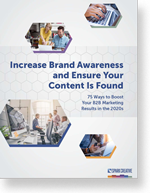
As a B2B marketer, you already have plenty to do. So, is it really that important to reinforce brand credibility?
Surely, branding is something consumer companies should be more preoccupied with. Does it really matter to the business decision makers you’re trying to convert into customers right now?
But in one important way, reinforcing B2B brand credibility is more critical than it generally is for consumer brands.
Remember, B2B companies have far fewer customers than a consumer brand typically would.
That means each customer’s perception of your brand has more impact on the health of your business. In fact, “71% of B2B customers are considering taking their business elsewhere,”1 according to one survey.
Think about that.
If two-thirds of your customers switched to a competitor next week, how long could your business survive?
“B2B companies that fail to focus on their brand and market it effectively are essentially neglecting their future and their clients.”2 –Neil Patel
So, let’s turn our attention to some ways to build and reinforce brand credibility for your B2B business.

1. Recognize the difference between short- and long-term goals.
The list of tools marketers use to track, monitor, and improve the performance of their marketing campaigns is now almost endless. And, while that’s a great development for improving campaign results, most popular metrics track activity during relatively short time windows.
Reinforcing the credibility of your brand is a long game.
It’s great to maximize the success of your marketing efforts – but don’t overlook brand credibility. A healthy, well-respected brand will serve you better over time.

2. Find ways to connect with your audience.
Two primary missions for your business are to:
• Better understand customers and
• Help them achieve their goals
Remember that success in the B2B world is all about relationships between real people. So, talk to them more. Phone, video, and face-to-face conversations with customers can generate insights you might have never been able to discover otherwise.

3. Provide high quality customer service.
This sounds basic, but good customer service does help you reinforce brand credibility, so it’s worth a mention.
Even large B2B companies generally have fewer than 100 customers that drive sales.3 With fewer key customers, making sure every one of them is satisfied is imperative.

4. Customize content for your customer’s interests.
So, you’ve worked to better understand your audience. Now, you must customize content and personalize experiences for them.
There’s good news here; the reason they found you in the first place is because you offer something that addresses their challenges.
But just because you’ve gained someone’s attention doesn’t mean you’ll keep their interest. Publish a range of content within your areas of expertise – then aim to personalize specific pieces for each customer based on their preferences.

5. Offer a great product or service.
Consider how hard it is to make a business-related sale. The price points are generally higher and often you’ve got to persuade a whole group of people on the merits of your offering to complete just one transaction.
So, your products and/or services must be compelling – and you should always be working to improve them.
Always aim to provide the best value possible. Because, if customers don’t get that from your business, they’ll look elsewhere.

6. Dare to be different.
Offering the best product or service is great. But, what really sets you apart over the long-term is telling people – and showing them – why you are different from all the rest.

7. Communicate clearly.
A growing number of businesses have been getting better at this, and frankly, it’s a relief. In fact, “90% of the most successful content marketers put their audience’s information needs first over their promotional message.”4 –Content Marketing Institute
A simple and direct style – in both speaking and writing – almost always wins out over unclear jargon.

8. Help users find what they need with simple website design.
Years ago, B2B companies could rely on the quality of their products, services, and website content to attract business and drive sales.
That’s not so anymore.
Buyers don’t trust websites filled with mistakes, dated design, and distractions. They expect well-crafted, functional websites that help them find answers to their questions fast.

9. Offer a rewarding customer experience (CX) online.
Without a doubt, CX is important for consumer brands. But don’t underestimate its importance for B2B. Remember, your customer base is probably far smaller than it is for a typical consumer brand. That means each satisfied customer is more important to your long-term success – and each interaction is an opportunity to shine.

10. Nurture relationships with your customers.
In the B2B world, your customer acquisition cost (CAC) is generally going to be higher than it would for consumer products. Let’s say your average CAC is around $900. If your core service sells for $499 a year, you’d need to hold onto each customer for an average of two years before you achieve a return. And in that same scenario, holding onto them for three or four years is far more preferable.
That’s why it’s so important to nurture the relationships you have with your customers. It’s critical to reinforcing brand credibility – and business survival.
So, stay in contact. Find out what they really like about your current products and offer them more. Deliver a rewarding customer experience. Brag about some clients on social media. And develop specialized content just for them.
Also remember; when a business person makes the decision to select your brand above all others, they are endorsing you to a certain extent. Don’t embarrass them in front of their colleagues. Don’t let them down.

11. Cultivate loyal customers who will refer, champion, and advocate for your brand.
You’ve read it before, but let’s say it again. It’s five times more expensive to find a new customer than to retain an existing one.
So then why do only 18% of companies prioritize retention over new customer acquisition efforts?
Does that make sense?
If you’ve brought a customer on board, it’s likely you’ve gathered a lot of useful data about them, including their contact details. Make this work to your advantage:
- The probability you can sell to an existing customer is over 60%. while the probability you can sell to a new prospect is only 5-20%.
- Existing customers are 50% more likely to try your new products.
- Existing customers may spend 31% more than new customers.
- Increasing customer retention rates by 5% can increase your profits by 25 – 95%.5
Have you considered building a reference program? The feasibility of this kind of initiative depends on what kind of resources your business can invest. But recognizing your best customers in a loyalty program can pay dividends for everyone concerned.
Offering them ways to improve their business or gain more professional exposure can greatly strengthen your relationship with them. And the more invested they are with you as a business resource, the more inclined they’ll be to remain loyal and refer you to their colleagues.
Summary & Takeaways
Though it doesn’t often get as much attention as your current marketing campaigns, brand credibility can be critically important. It’s not something you’ll earn from your audience overnight, but it’s worth the effort.
“Brand credibility is the difference between a one-time customer and a long-term customer. The value that a long-term customer can bring is indispensable.”6 –Forbes
Here, we’ve outlined a number of ways you can reinforce brand credibility online. Remember:
- Building brand credibility is a long-term game, but the benefits can last longer too.
- Learn more about your customers. Continue to shape your content and offerings in ways that help them succeed. Their success is strongly linked to yours.
- Communicate clearly and optimize your online properties so customers can find what they need quickly.
- Deliver a rewarding customer experience that brings them back to your website (or app) over and again.
Invest reasonable resources into retaining your customers for the long haul. A happy customer who champions your brand among their colleagues can literally be worth their weight in gold.
Start Boosting Brand Awareness Now
Want to drive more qualified customers to your content? Get this eBook, packed with 75+ ideas to help you attract more prospects quickly. (Complete the form so we know where to send the link.)
Sources include:
1. “Why B2B Leaders Should Rethink the True Cost of Large Accounts,” Jeff Durr, John H. Fleming, Gallup, October 2017
2. “Brand Bias: Does Branding Matter For Driving Sales in B2B? Here’s What The Data Says,” Neil Patel, NeilPatel.com, 2019
3. “How to Connect with Your Customers: B2B Marketing 101,” Dave Landry, National Center for the Middle Market, 2014
4. “B2B Content Marketing 2019; Benchmarks, Budgets, and Trends; North America,” Content Marketing Institute, 2019
5. “Customer Acquisition Vs.Retention Costs – Statistics And Trends,” Khalid Sales, Invesp, 2018
6. “Improving Brand Credibility In 2017: What Can We Learn From Brands Like Warby Parker And Casper,” Gabriel Shaoolin, Forbes, January 2017

